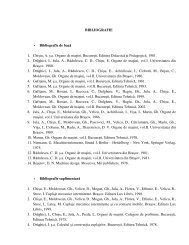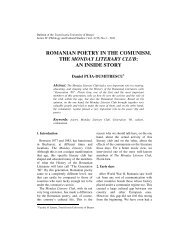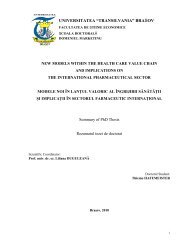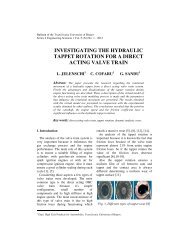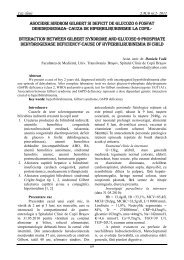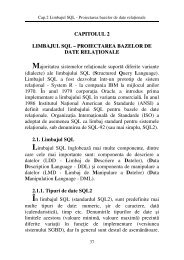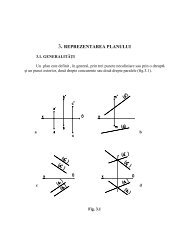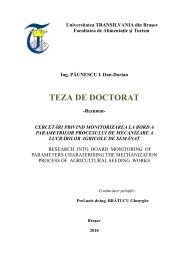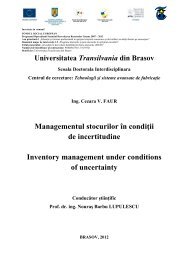TRACING ZERLINA'S ANCESTORS
TRACING ZERLINA'S ANCESTORS
TRACING ZERLINA'S ANCESTORS
Create successful ePaper yourself
Turn your PDF publications into a flip-book with our unique Google optimized e-Paper software.
78<br />
Bulletin of the Transilvania University of Braşov • Series VIII • Vol. 5 (54) No. 2 - 2012<br />
Some character names are changed<br />
accordingly corresponding to the place of<br />
the action. For instance, Molière’s<br />
protagonists are French: Charlotte and<br />
Pierrot, Bertati’s characters are Italian:<br />
Maturina and Biagio.<br />
2. Tirso de Molina’s Tisbea<br />
Zerlina’s first ancestor is De Molina’s<br />
Tisbea. By her demeanor and actions,<br />
Tisbea becomes the most intriguing and<br />
interesting female character in El Burlador<br />
de Sevilla y convidado de piedra. She<br />
represents the traditional mythical type<br />
modeled on the disdainful shepherdess<br />
figure of the sixteenth century pastoral<br />
stories. She is beautiful, but not sociable,<br />
aloof from many male admirers. Her real<br />
fascination sits in her individuality. What<br />
captures our attention are the<br />
contradictions in her character and the<br />
powerful passion, which boils under her<br />
beauty. We notice her delight in the<br />
sufferings of her suitors; delight, which<br />
comes not from her indifference, but from<br />
her trust in herself and her belief that she,<br />
controls the situation. Tisbea finds it<br />
difficult to resist Don Juan’s pursuing.<br />
Abandoned by Juan, after he promised to<br />
marry her, Tisbea degrades beyond<br />
desperation. Juan’s betrayal pushed her to<br />
attempt suicide. Tisbea’s outrage and<br />
excessive violence come from a conscious<br />
downfall, not from self-pity awareness as a<br />
victim of Don Juan’s perfidy. She<br />
continues to live but conducted by a new<br />
motto: all men are not to be trusted. Even<br />
more disturbing thought for her, to which<br />
she has not found the answer remains: in<br />
given circumstances, can she trust herself?<br />
3. Tirso de Molina’s Aminta<br />
Another peasant character, which I have<br />
been initially taken as one of Zerlina’s<br />
ancestors in De Molina’s El Burlador de<br />
Sevilla y convidado de piedra. is Aminta.<br />
Unlike Tisbea, Aminta is psychologically<br />
less complex. She is a naïve country girl,<br />
who is flattered and overwhelmed by Don<br />
Juan’s attentions. Generally, Aminta seems<br />
more honest than any other woman in the<br />
De Molina’s play. She simply gets<br />
annoyed when Batricio, her fiancé, reacts<br />
unfavorably to Don Juan’s arrival. Aminta<br />
protests when Don Juan enters in her<br />
bedroom at night. Although flattered by his<br />
words, Aminta’s good sense tells her not to<br />
trust him. She accepts his offer for<br />
marriage but only after the Don convinces<br />
her that Batricio has abandoned her.<br />
Aminta could possibly represent<br />
Zerlina’s direct correspondent in De<br />
Molina’s play. One of the reasons could be<br />
the fact that the wedding scene from the<br />
play, No.7, corresponds with scene No. 5<br />
in Da Ponte’s libretto. Nevertheless,<br />
Aminta is not created as a sharp and<br />
interesting peasant girl. Tisbea embodies<br />
those features. In the whole setting of the<br />
play Aminta remains a pale figure, unlike<br />
Tisbea, whose characteristics are clearly<br />
portrayed. This is the main reason for<br />
which Tisbea is considered the first Zerlina<br />
in the literature.<br />
4. Andrea Cicognini’ Rosalba<br />
The earliest Italian version of Don<br />
Giovanni plays is Il Convitato di pietra<br />
written probably in 1632 by Giacianto<br />
Andrea Cicognini. His play is based on the<br />
De Molina’s El Burlador de Sevilla y<br />
convidado de piedra and follows closely<br />
the action, which takes place this time in<br />
Italy: Naples and Castile. Cicognini keeps<br />
most of Tirso De Molina’s characters. We<br />
find Tisbea in Rosalba, a fisher woman,<br />
who saves Don Giovanni from the sea. She<br />
is added to Don Giovanni’s catalogue of<br />
conquests, fact not mentioned in Juan’s list<br />
from El Burlador de Sevilla y convidado<br />
de piedra. Although she follows the action,




